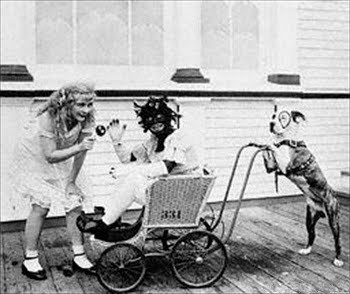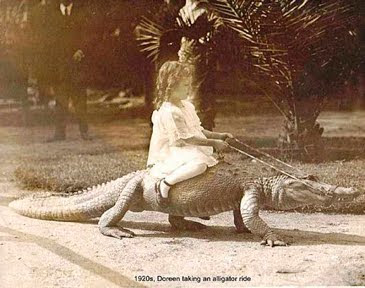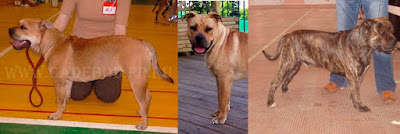The pit bull apologia would have you believe that their fighting bred dogs are just like any other dog in many ways, but so superior in their unparalleled love and devotion for children they were commonly known as "The Nanny Dog" throughout the late 19th and early 20th centuries. If pit bulls are held in low esteem today, it is only due to ignorance and the gullible acceptance of biased news reporting because, once upon a time, pit bulls were the most beloved dog in England and the United States.
A google search brings up 77,100 results for the term "nanny dog." While some sites bestow the Nanny Dog mantle on the American Pit Bull Terrier or the American Staffordshire Terrier and some lead you to productions of Peter Pan, most of the results lead you to 21st century blogs and news articles about the Staffordshire Bull Terrier.
120 sites dedicated to the Staffordshire Bull Terrier include this phrase in support of the fighting nanny dog mythology,
"These dogs were renowned for their courage and tenacity and despite their ferocity in the pit were excellent companions and good with children. In fact it was not unknown for an injured dog to be transported home in a pram with the baby!"
Frankly, even if this anecdote were plausible, let alone true, this doesn't support a nanny dog claim so much as it supports a sociopathic, baby abusing, dog abusing, parent claim.
Dig as hard as you want, the pram story is all you'll find to support the Nanny Dog myth in any of these sites. You won't find a single citation, quote or reference of any kind to a 19th century, or early 20th century text. Since the Staffordshire Bull Terrier enthusiasts didn't see fit to support their claims, I decided I would have to find the origin of the Nanny Dog myself.
Meet the Nanny Dog - the Staffordshire Bull Terrier, England's ultimate fighting dog and, inexplicably, the supposed dog of choice to care for England's children in the 19th and early 20th centuries.
It is not hard to find old references to the Bull Terrier. The various histories and descriptions of the breed largely agree with each other. After bull baiting was banned in England, Coalminers in various cities including Staffordshire were at a loss for blood sporting alternatives for their beloved, courageous bulldogs. So, they developed another blood sport - pit dog fighting. Sadly, they soon found their bulldogs were not suited to win in the pit.
"The old lovers of the bulldog found to their dismay that sometimes a terrier, with only quickness and a pair of punishing jaws to recommend him, would kill a bulldog while the latter was merely hanging on. The bulldog would be brave to the death of course, and would withstand pain that the terrier would never endure, but that was poor consolation when the terrier had killed the dog.The dog fighters were, however, as persevering a set of men as were the bull baiters, and they set to work to remodel their favorites for their new occupation. They began to cross their bulldogs with the white English terrier, a breed now practically extinct, but the same in every respect, save color, as the modern Manchester or black-and-tan. The progeny was named the bull terrier, the greatest fighting machine, pound for pound, on four legs. The bull terrier had the courage of the bulldog and the jaws and quickness of the white terrier. Moreover, he has the terrier's way of fighting. He does not simply take a hold and stay there. He takes a hold and begins to eat his way through and tear and worry. If his first hold doesn't suit, he takes another. If he gets his adversary by the throat, he will tear out the throat in a minute or so and end the battle.""There is perhaps no more beautiful illustration of the results of artificial selection than is provided in the history of the bulldog. It is a wonderful example of patient and skillful breeding for an object that is not wholly ignoble.
We can agree to disagree on that last point.
It is a bit confounding that the New York Times author neglected to mention the Staffordshire dog fighter's even more stupendous genetic achievement, that of creating an unstoppable "fighting machine" that can also be used to nanny their children.
Nineteenth century dog breed books, such as The Illustrated Natural History (Mammalia), by Rev. JG Wood (1853), and The Dogs of the British Islands, by J.H. Walsh (1878) very precisely describe the deadly nature of the Bull Terrier, including an account of a Bull Terrier's attack on a rhinoceros by a dog "called Venus in derision of her ugliness."(Wood, p. 311) Walsh suggests that, "unlike the bulldog, he (the Bull Terrier) is an excellent companion for the male sex, being a little too violent in his quarrels to make him desirable as a ladies' pet (p. 221)." Nanny Dog? Not so much.
In 1894, Rawdon B. Lee wrote A History and Description of the Modern Dogs of Great Britain and Ireland in which he explains that in the middle of the 19th century, fanciers began to breed bull terriers as "a gentleman's companion" and began showing them. It was about this time that the Staffordshire Bull Terrier began to be recognized as distinct from the Bull Terrier. The Kennel Club in England recognized the Bull Terrier in the last quarter of the 19th century, and the Staffordshire Bull Terrier became the pit fighting dog of choice. The Staffordshire Bull Terrier was denied Kennel Club recognition until 1935 because of its reputation as a pit fighting dog.
Lee illustrates the Bull Terrier's unsavory past by revealing that Bulls-eye, one of the meanest dogs in literary history and Bill Sykes' sidekick and alter ego from Oliver Twist (1838) was a Bull Terrier. Dickens describes Bull's-Eye as having a face "scratched and torn in twenty different places..." and..."who by a certain malicious licking of his lips seemed to be meditating an attack up on the legs of the first gentleman or lady he might encounter in the streets when he went out." Charles Dickens also seemed unaware of the Bull Terrier's special powers as a nanny, but was aware of the pit bull's capacity for human aggression.
Charles Dickens' Bill Sikes and Bull's-Eye
Lee (p. 23) contends, "our modern Bull Terrier is a very different creature from what he was half a century ago." According to Lee, they had been perhaps the most popular dog in England, until they were recently supplanted by the Fox Terrier. They were kept for pets and companions, they gained recognition in dog shows, and became fashionable to own among the undergraduates at Oxford and Cambridge. If any pit fighting dog might have been called England's Nanny Dog, surely it would have been the white Bull Terrier. And yet there is no mention of it.
Mr. Lee is perhaps the first recorded pit nutter. He penned what might be the first known iteration of, "It's how you raise them" (p.22, p. 26) which is hilariously followed by the woeful tale of the demise of Mr. Lee's own beloved Bull Terrier, Sam. Sam was incredibly talented and an incomparable companion who, owing to fighting blood on his sire's side, became increasingly aggressive. After killing at least two dogs, Sam was dumped at a warehouse to be a guard dog where he died of a broken heart. 30 years later, Mr. Lee still laments the incredible and bloodthirsty Sam. But, I thought it was how you raise them...
As for 19th century mentions of the "Staffordshire Bull Terrier" that can be found online, there is one. It is a want ad for a fighting dog:
Pleshey Chelmsford Wanted a Staffordshire bull terrier dog must have an exceedingly long nose and thoroughly game to face anything and win A tried dog preferred PS For special purpose weight 34 lb 944 (1871 Exchange and Mart and Journal of the Household (p. 614))
Archive searches of British, American and Canadian newspapers going as far back as the 18th century turn up not one single mention of "Nanny Dog" with regards to ANY breed until 1904 when the first stage production of Peter Pan opened featuring a nursemaid dog named Nana. Though J.M. Barrie patterned Nana after his Landseer Newfoundland, Nana has been portrayed by a St. Bernard, and an Old English Sheep Dog in subsequent stage and screen productions. No mention of Nana ever being a Staffie Bull. Not even in Never Never Land.
So, where is the oldest known reference to the Staffie Bull as a nanny dog? In a New York Times article. In 1971, Walter R. Fletcher wrote an article entitled, "A Breed That Came Up the Hard Way" in which he interviewed William R. Daniels and Mrs. Lilian Rant, President and magazine editor for the Staffordshire Bull Terrier Club of America on the eve of the Staffie Bull's being granted permission to be shown in the American Kennel Club's miscellaneous class. It's the first step to AKC recognition and the club wanted to polish their dog's image.
Daniels brings up Dickens' villainous Bull's-Eye again and Mrs. Rant acknowledges that the Stafford "had an unsavory reputation for fighting and violence and his name became associated with ruffians, who cared little for him as a dog but only for his ability in the pit. The Stafford we know today quickly becomes a member of the family circle. He loves children and is often referred to as a 'nursemaid dog.'"
Well, there it is. Mrs. Rant, lover and promoter of the Stafford, is clearly speaking in the present tense about the dog of today (1971) currently being referred to as a 'nursemaid dog' in the United States. She is using a variation of the argument that Mr. Lee used 77 years before about the Bull Terrier, suggesting that the Staffordshire Bull Terrier's unsavory reputation as a fighting dog has been left in the far distant past. She harkens back to Dickens again, before the Staffordshire Bull Terrier even existed as a distinct breed. Her contention that Staffordshire Bull Terriers are OFTEN referred to as nursmaid dogs is a little bit of a stretch, too. In 1971, there were 99 registered Staffordshire Bull Terriers in the United States. As editor of the club's magazine, she must have been at the center of all conversation about the breed. It is likely that she either coined the nickname or promulgated it through the magazine, and the term may have gained popularity among those few Stafford enthusiasts who subscribed to her magazine.
A timeline search does not turn up a mention of the "nanny dog" until 1987 in an archived Toronto Star article entitled, Move to Outlaw Pit Bulls Under Study in Several Cities.
"Breeder Kathy Thomas, president of the Staffordshire Bull Terrier Association said, 'We're aware of the fighting - there's a lot of it in the Hamilton area. We only sell to family homes.'"
"Thomas, mother of two young children, said her eight Staffordshires are 'wonderful with children. In England, our Staffies were called the nanny-dog because they were gentle with kids.'"
Here's where the lie begins to get twisted into its most bizarre and current form and the Nanny Dog myth jumps on the crazy train. The Nanny Dog argument is no longer valid in the way that Mrs. Rant used it in 1971 when the general public was not aware of contemporary dog fighting. By the 1980s, dog fighting had become a generally recognized problem and initiatives to ban pit bulls were beginning. Kathy Thomas acknowledges that there is dog fighting going on all around her in 1987 near Toronto. She can no longer say that the Staffie was once, long ago, in Dickensian England a fighting dog, but has been transformed by many years of selective breeding to be a gentle nanny dog. The dogs are fighting all around her. So, the lie becomes that Staffordshire Bull Terriers were ALWAYS known as nanny dogs. They snuggled with the babies by day, ripped out throats and gutted each other by night and, returning from the fight, snuggled once again with the baby in the pram, this time ripped to shreds and soaked in blood.
It took about 16 years for the story to mutate into the Nanny dog of England - historic fighter and lover of children. But, the myth did not really take off for another 4 years, when Mrs. Rant published her book in 1991, Staffordshire Bull Terriers: Owner's Companion. She uses the term "nursemaid dog" three times and significantly says, " He has a great affection for children, having earned the title 'nursemaid dog' many years ago." (p.117) In this instance, "many years ago" means about 20 years previous, when she first coined or adopted the term.
And how about the history of the term "America's Nanny Dog" referring to the American Pit Bull Terrier or the American Staffordshire Terrier? 5,570 results come up for that query. Again, you cannot find one single citation, source or reference to a text from the 1940s that confirms this assertion. A google timeline search for "America's Nanny Dog" shows the earliest online publication date is September 25, 2007 as an opinion piece in the online publication, Times-Standard entitled "America's Nanny Dog" by Tyla Hafstrom. It is a complete fabrication and an utter lie.
Go ahead and prove me wrong, not with a single primary source, but with a preponderance of evidence that demonstrates the incredible existence of the baby loving fighting dog that was so beloved and so popular in times gone by that it was commonly called the nanny dog.
This, by the way, doesn't count.
This is the truth of the Stafforshire Bull Terrier today. Note this one is in fighting trim and has a a heavily scarred muzzle. This ain't no nanny dog.
~We lie loudest when we lie to ourselves.
Eric Hoffer
8/4/10
8/4/10























































